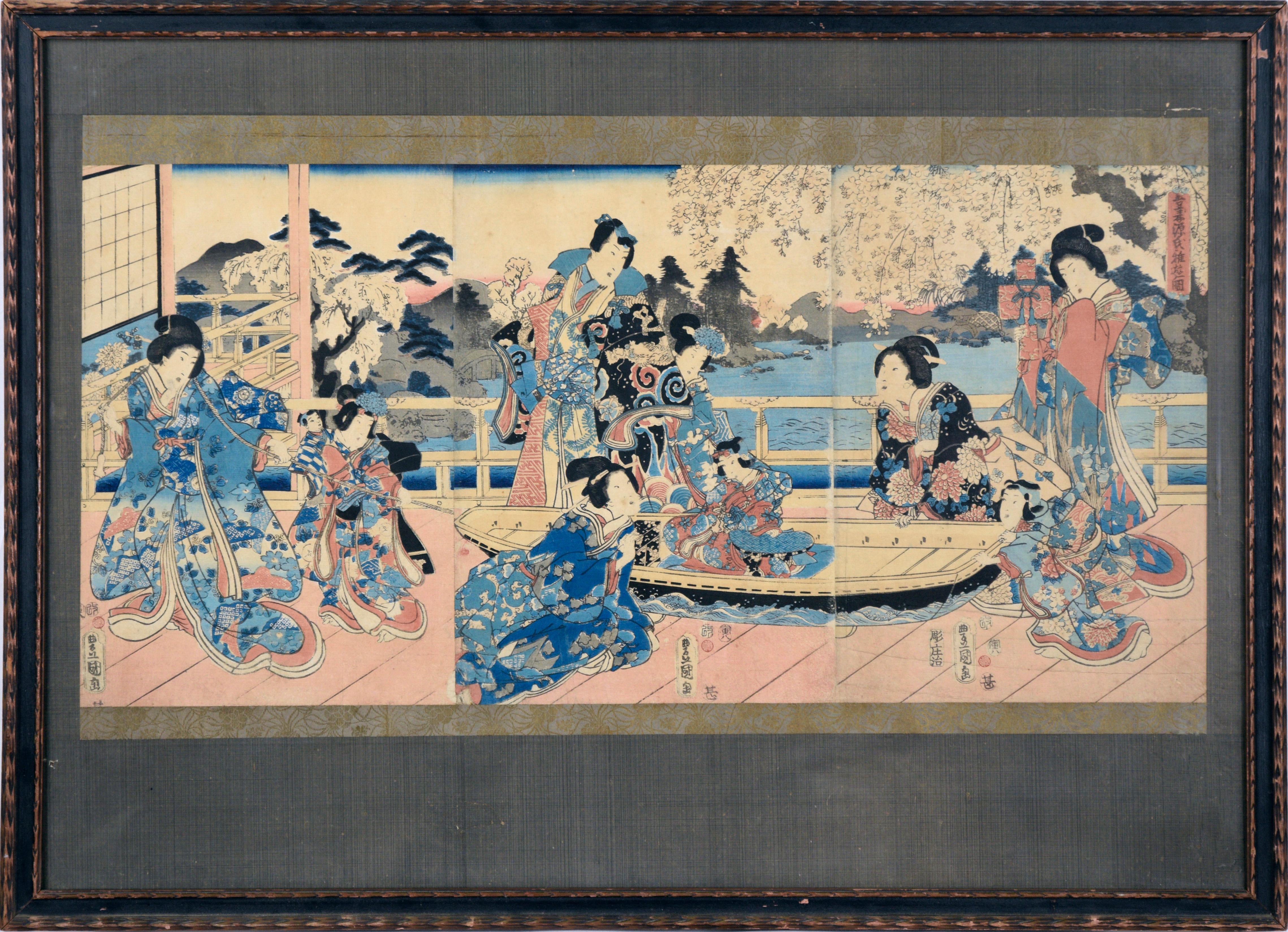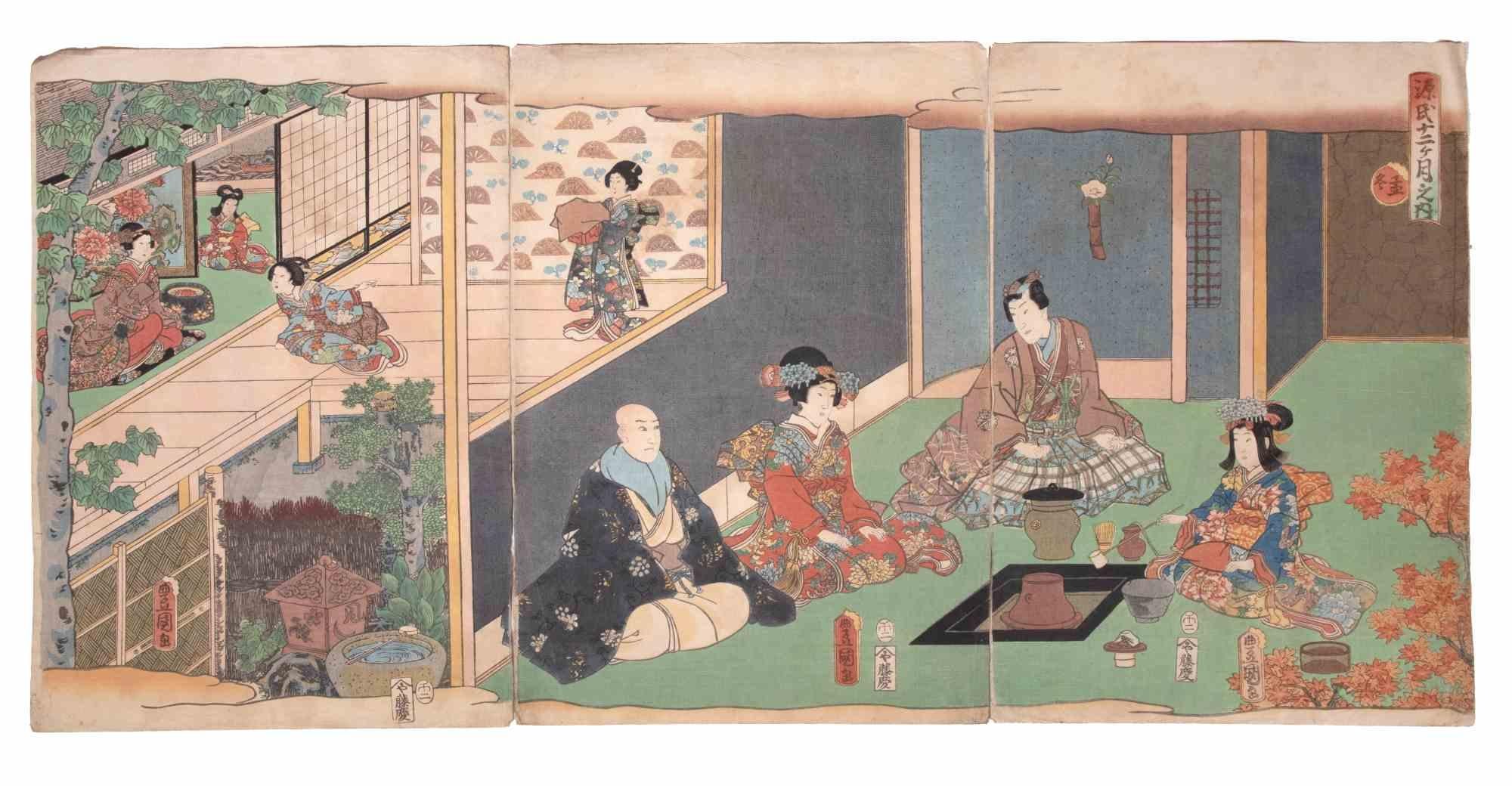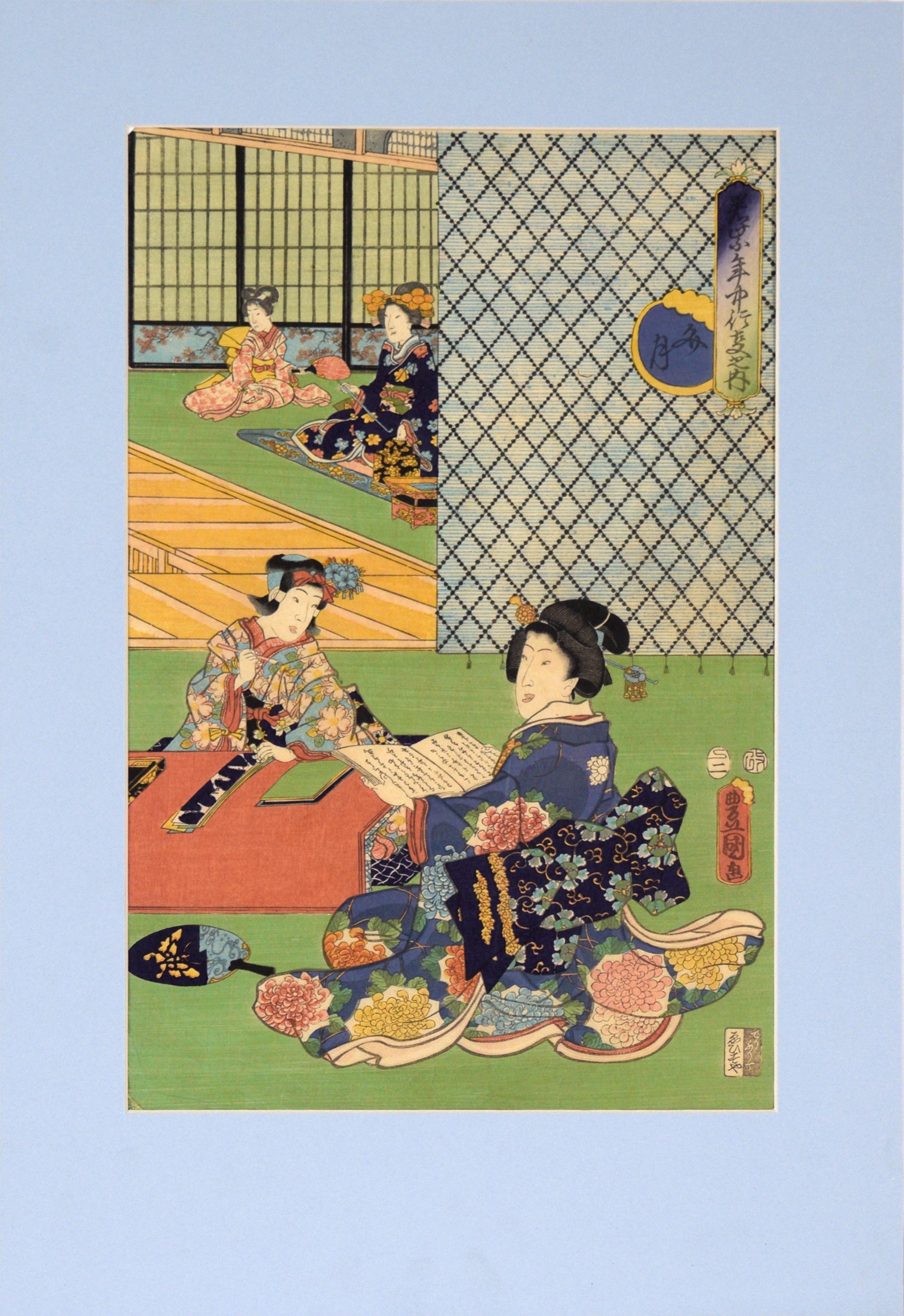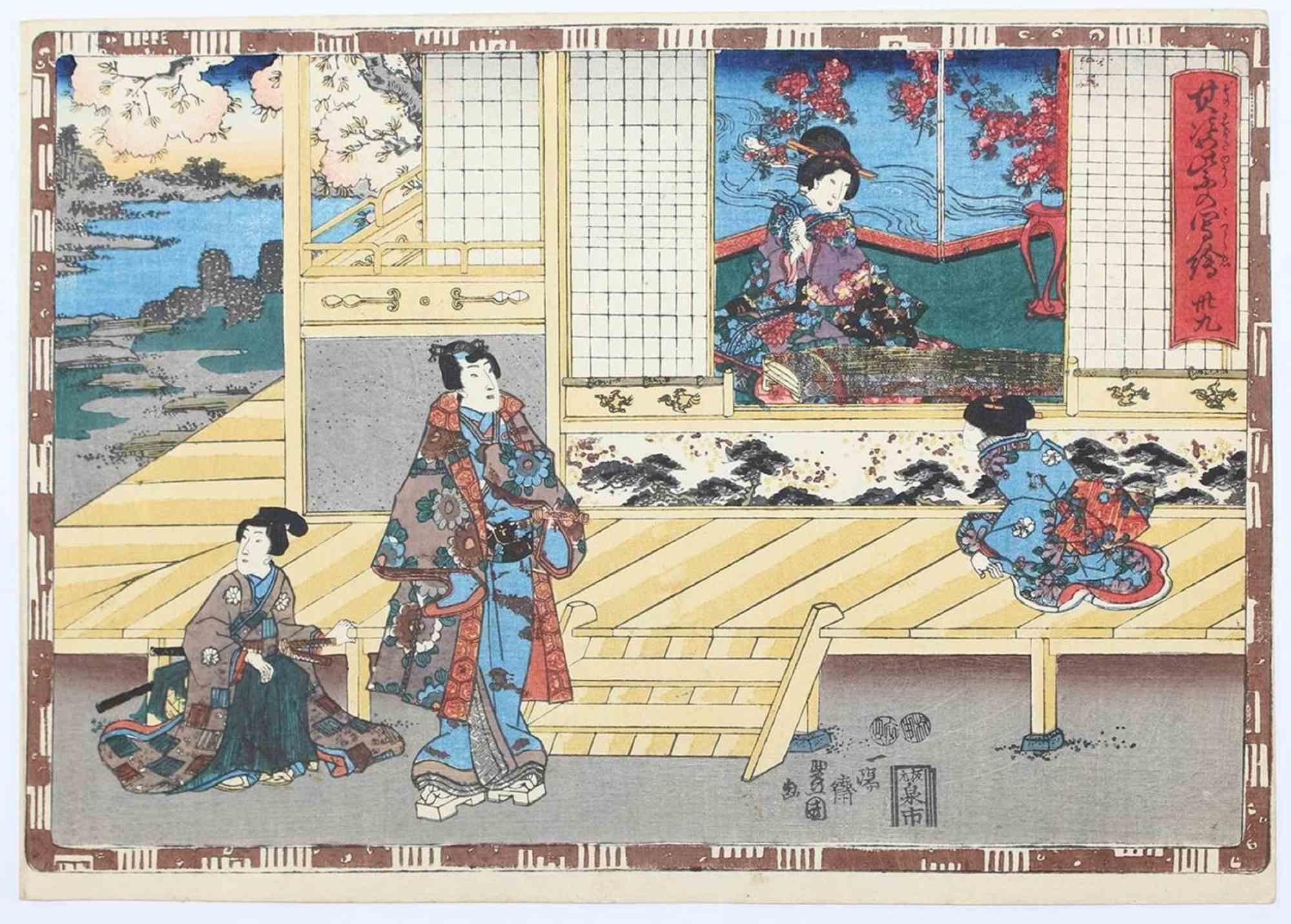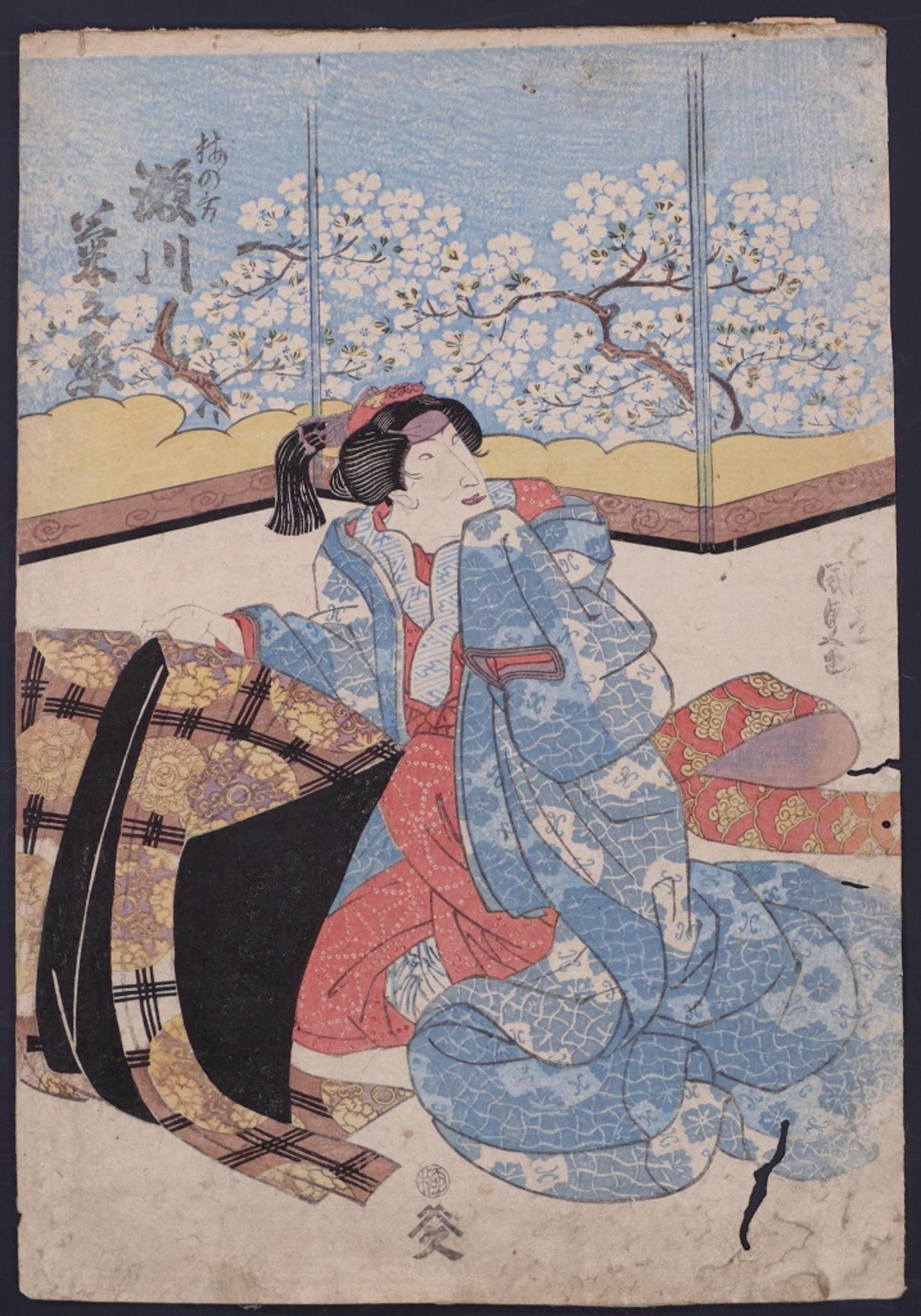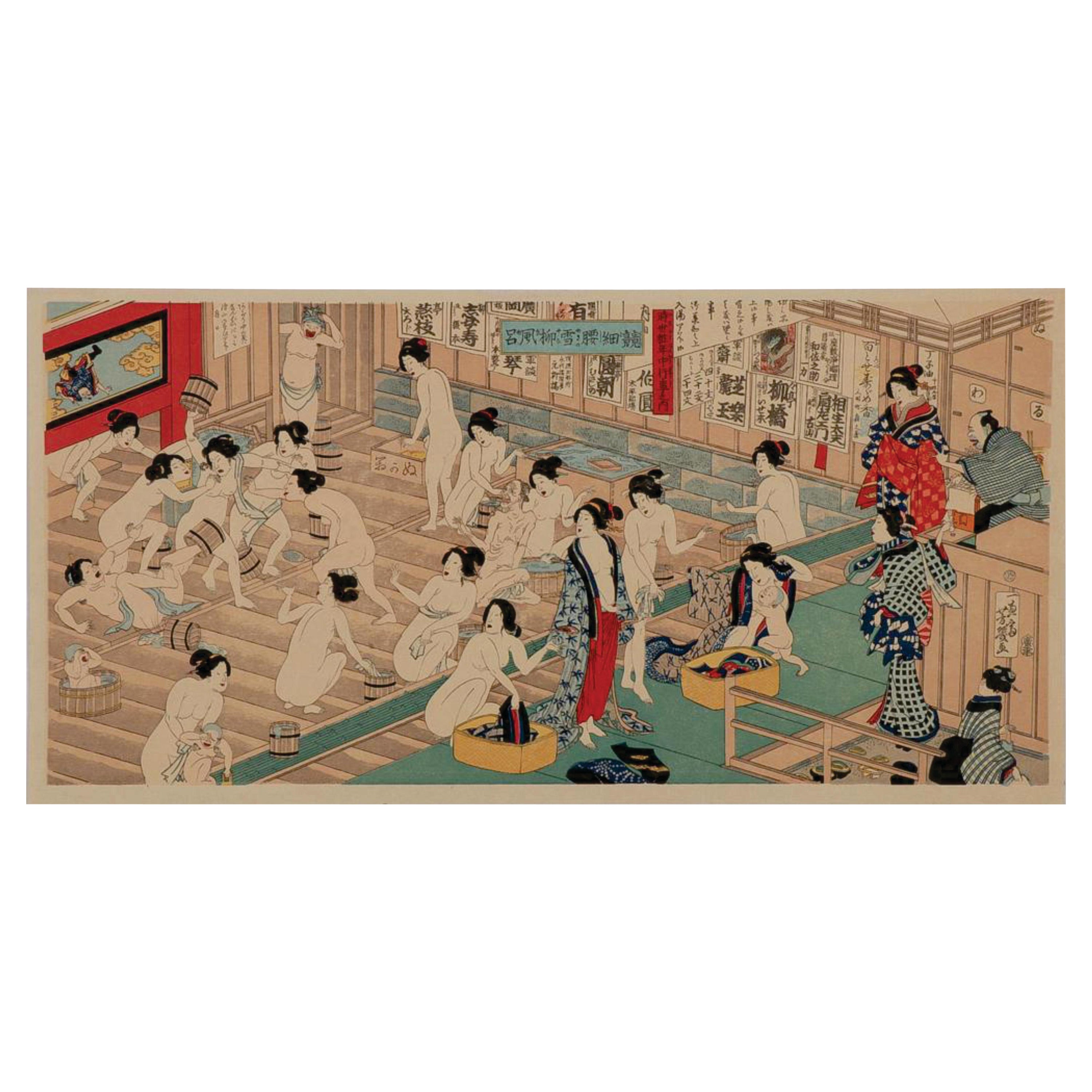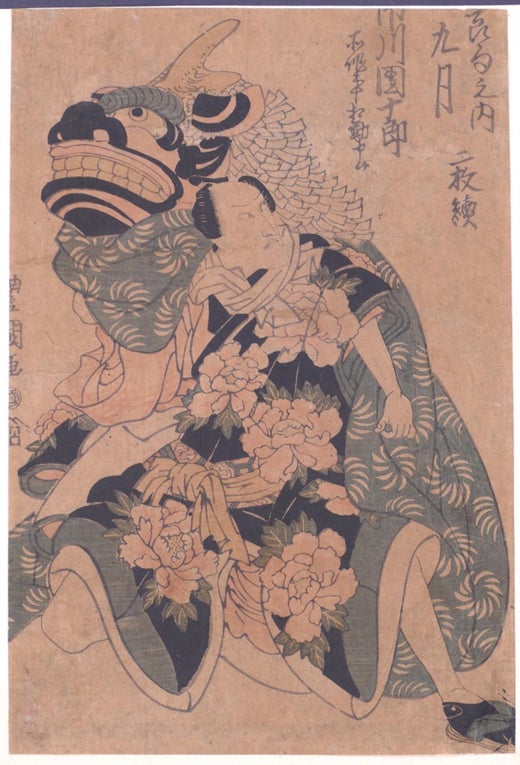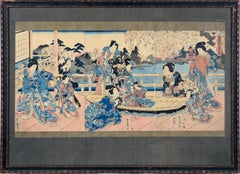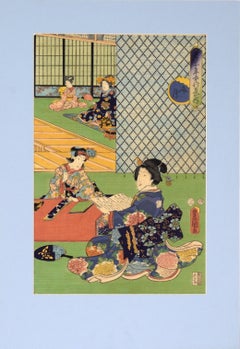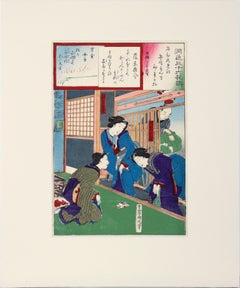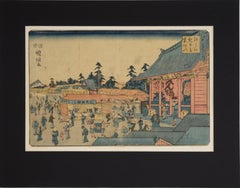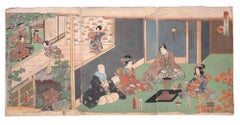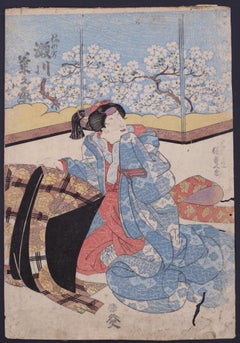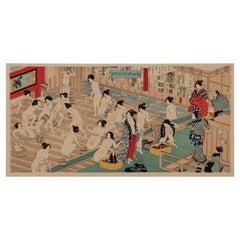Items Similar to "Various Himochi" Wagashi Festival Japanese Woodblock Print by Utagawa Toyokuni
Want more images or videos?
Request additional images or videos from the seller
1 of 10
Utagawa Toyokuni"Various Himochi" Wagashi Festival Japanese Woodblock Print by Utagawa Toyokuni19th Century
19th Century
$1,480
$1,85020% Off
£1,129.28
£1,411.6020% Off
€1,284.64
€1,605.8020% Off
CA$2,078.40
CA$2,59820% Off
A$2,274.56
A$2,843.2020% Off
CHF 1,201.90
CHF 1,502.3820% Off
MX$27,148.36
MX$33,935.4420% Off
NOK 15,337.80
NOK 19,172.2520% Off
SEK 14,027.66
SEK 17,534.5820% Off
DKK 9,595.60
DKK 11,994.5020% Off
About the Item
"Various Himochi" Wagashi Festival Japanese Woodblock Print by Utagawa Toyokuni
Rare oversized early 19th century 5-tiered woodblock by Utagawa Ichiyosai Toyokuni, (Japan, 1769-1825), a Japanese lord and wife oversee a sekku festival of food, music, and dolls or toys. '"oshi" is the first day of “Mi (Snake)” in the third month of the lunar calendar. This day, known in modern Japan as the Girls' Festival, originated in China as a form of purification ceremony in which water and drinking peach blossom wine were used to drive away evil. Many kinds of hishi-mochi appear in this picture of hina ningyo (dolls associated with Hinamatsuri, or the Girl’s Day) from Omochae.
The custom of eating special dishes at events throughout the year and at milestones in people's lives has existed since ancient times. This paragraph specifically focuses on the annual event called sekku, and life events that involve eating sweets. Joshi is the first day of “Mi (Snake)” in the third month of the lunar calendar. This day, known in modern Japan as the Girls' Festival, originated in China as a form of purification ceremony in which water and drinking peach blossom wine were used to drive away evil. According to the Keiso saijiki, in ancient China, on the third day of the third lunar month, people ate “ryuzetsuhan,” which is the juice of gogyo (Jersey cudweed) mixed with rice flour and nectar. In Japan, there is a record in the Heian period history book Nihon Montoku tenno jitsuroku [839-5] that it was an annual event to make kusamochi using gogyo on the third day of the third month of the lunar calendar, which may have been influenced by Chinese customs.
The tradition of eating kusamochi on the third day of the third month of the lunar calendar continued after that. By the Edo period, however, hishimochi had come to be used as a sweet to serve on the third day of the third month. A picture of a hishimochi is included in the Morisada manko , which we mentioned in Part 1. According to it, hishimochi in the Edo period were often three layers of green-white-green instead of the now common red-white-green. However, it is possible to see from our collection that not all hishimochi were made in this way. Omochae published in 1857, is a good example. Omochae is a type of ukiyoe print which was designed for children to play with, and was popular from around the Ansei era (1854-1860) to the middle of the Meiji period. In this print, which was published close to the time of the compilation of Morisada manko, hishimochi are three layers of white-green-white. Some of the ukiyoe of the Girls’ Festival depict hishimochi in five layers of white-green-white-green-white, and this variety is interesting.
Artist's seal and signature in lower right corner is cut off. date sill center right.
Presented in a new white mat.
Frame size: 26.75"H x 21.75"W
Image size: 18.75"H x 13.25"W
(One uncommon type from this period, one which is easy to confuse with later seals, was used during the period 1815 to 1832, and includes a zodiacal date in the top part of an oval seal, along with an aratame character below.)
Third Period
In 1842, the whole system was reformed, and replaced by individual censors called Nanushi. They marked prints with their individual round seals, bearing characters from their names. During the period from 1842 to 1846, these seals are found singly (see sample illustration at right). There are roughly a dozen of these seals; for a beginner to tell if a seal on a print is one of them, it is necessary to check a table of them. With time, it becomes easy to tell if a single round seal is a nanushi seal, or some other kind. They are sometimes found with a zodiacal date seal and/or an aratame seal. 'Murata' seal, 1846
From 1847 to 1853, the Nanushi marked prints in pairs; these seals are usually directly next to each other, but on rare occasions they are separated. The fact that they are usually found next to one another makes them easy to recognize; in general, no other round seals come in pairs. An oval aratame seal is usually present during the period from 1848 to 1851. During the period 1852-1853, a zodiacal date seal is also present.
- Creator:Utagawa Toyokuni (1769 - 1825, Japanese)
- Creation Year:19th Century
- Dimensions:Height: 26.75 in (67.95 cm)Width: 21.75 in (55.25 cm)Depth: 0.25 in (6.35 mm)
- Medium:
- Movement & Style:
- Period:
- Condition:Very good condition, some tonal aging to paper, trimmed and old rice paper glued on corners.
- Gallery Location:Soquel, CA
- Reference Number:Seller: ANS90711stDibs: LU54213877582
Utagawa Toyokuni
Utagawa Toyokuni[a] (歌川 豊国; 1769 – 24 February 1825), also often referred to as Toyokuni I, to distinguish him from the members of his school who took over his gō (art-name) after he died, was a great master of ukiyo-e, known in particular for his kabuki actor prints. He was the second head of the renowned Utagawa school of Japanese woodblock artists, and was the artist who elevated it to the position of great fame and power it occupied for the rest of the nineteenth century.
He was born, the son of Kurahashi Gorobei, a carver of dolls and puppets, including replicas of kabuki actors.
At around 14, Toyokuni was apprenticed to the first head of the Utagawa house, Utagawa Toyoharu, whom his father knew well and who lived nearby.
One of his fellow pupils under Toyoharu was Toyohiro, whose pupil was the great landscape artist Hiroshige. In recognition of his artistic ability, Toyokuni later took the name Utagawa Toyokuni, following the common practice of using one syllable of his master's name.
Toyokuni seems not to have been an "intuitive genius"determined to forge a new path; rather, he seems to have studied intently those who came before him, particularly Utamaro, Chōbunsai Eishi and Eishōsai Chōki and through a great deal of hard work produced first a mastery, and then a synthesis of their styles, to create a style of his own.
He was known mostly for his prints related to the kabuki theatre, in particular his yakusha-e actor portraits, a field which he took to new heights. He also, however, produced other genres such as musha-e warrior prints, shunga erotica, and most notably bijin-ga.
In his actor prints, like Sharaku, one sees the real subject; but his prints merely portrayed what he saw, unlike Sharaku who exaggerated those aspects he saw as the most key. It is said of Toyokuni's prints that they recreate exactly what one would see on stage; they show actors acting, not merely just pictures of actors.
Together, these characteristics made Toyokuni's prints far more popular among theatre-goers than Sharaku's, although history has come to judge Sharaku the keener observer and greater artist.
His popularity and prolific output may in part have been his undoing, though. From 1803 through 1817, his work became more static, even as it became more popular. He continued to produce large quantities of prints, but the quality as a rule did not match that of his earlier days. Occasional prints from this period, however, show his old brilliance
About the Seller
5.0
Platinum Seller
Premium sellers with a 4.7+ rating and 24-hour response times
Established in 1986
1stDibs seller since 2014
3,057 sales on 1stDibs
Typical response time: <1 hour
- ShippingRetrieving quote...Shipping from: Soquel, CA
- Return Policy
More From This Seller
View AllElegant Amusements of Eastern Genji - Japanese Triptych Woodblock Print on Paper
By Utagawa Kunisada (Toyokuni III)
Located in Soquel, CA
Elegant Amusements of Eastern Genji - Japanese Triptych Woodblock Print on Paper
Dynamic woodblock print with several elegantly dressed figures by Utag...
Category
1850s Edo Figurative Prints
Materials
Paper, Ink, Woodcut
Annual Events for Young Murasaki (July) - Tales of Genji - Japanese Woodblock
By Utagawa Kunisada (Toyokuni III)
Located in Soquel, CA
Annual Events for Young Murasaki (July) - Tales of Genji - Japanese Woodblock
Rightmost panel a triptych, depicting monthly events for Wakamurasaki (Young Murasaki). This is the month of July. There appears to be a lesson taking place, possibly for writing or poetry.
Artist: Toyokuni III/Kunisada (1786 - 1864)
Publisher: Ebisu-ya Shoshichist
Presented in a new blue mat.
Mat size: 19"H x 13"W
Paper size: 14.5"H x 10"W
Commentary on the triptych:
In the Edo period, Tanabata was designated as one of the five seasonal festivals, and became an annual event for the imperial court, aristocrats, and samurai families, and gradually came to be celebrated by the general public. Its origins are said to be a combination of the Kikoden festival, which originated from the Chinese legend of Altair and the Weaver Girl, and Japan's ancient Tanabata women's faith. Ink is ground with dew that has accumulated on potato leaves, poems and wishes are written on five colored strips of paper, which are then hung on bamboo branches to celebrate the two stars that meet once a year. Although the illustration is a Genji painting...
Category
1850s Realist Figurative Prints
Materials
Printer's Ink, Rice Paper, Woodcut
"Enshoku Sanju-roku Kasen" (Thirty-six Enchanting Flowers) Woodblock on paper
By Toyohara Kunichika
Located in Soquel, CA
"Enshoku Sanju-roku Kasen" (Thirty-six Enchanting Flowers) Woodblock on paper
Elegant woodblock print by Toyohara Kunuchika (Japanese, 1835-1900). Three women are in talking with each other inside, while a man waits outside holding a bag of some kind. The colors in this piece are rich and saturated, primarily blues, greens, and purple.
Mat size: 16"H x 20"W
Paper size: 14.75"H x 9.88"W
Born in 1835, Toyohara Kunichika grew up in the Kyobashi district of Edo in the midst of merchants and artisans. In 1848, at age 13, he was accepted as an apprentice into the studio of Utagawa Kunisada I...
Category
1880s Edo Figurative Prints
Materials
Ink, Rice Paper, Woodcut
"The Kaminarimon at the Kanseon Temple in Asakusa" - Original Japanese Print
Located in Soquel, CA
"The Kaminarimon at the Kanseon Temple in Asakusa" - Original Japanese Print
Japanese Print "The Kaminarimon at the Kanseon Temple in Asakusa", from the series "Famous Places in Ed...
Category
1850s Showa Figurative Prints
Materials
Rice Paper, Woodcut
Japanese Artisans - Silk Dying -Japanese Woodblock Print
By Tosa Mitsuyoshi
Located in Soquel, CA
Japanese Artisans - Japanese Woodblock Print J
Japanese woodblock depicting six women, all wearing vibrant kimonos, working on crafts by Tosa Mitsuoki (Japanese, 1617-1691). Japanese,c. 1600. Handcraft depiction (dye works).Section from a painted screen with presentations of handcraft.Kita-in, Saitama.
Stamped lower left.
Presented in a white mat and giltwood frame.
Frame: 19"H x 14"W
Mat: 18.25"H x 13.25"W
Image: 14.5"H x 9.5"W
Tosa Mitsuoki was a Japanese painter, reinvigorating the Yamato style of classical Japanese painting. Yamato-e originated from interest in reproducing early Tang dynasty paintings, and was later reinvented and further refined to fit Japanese cultural perceptions in the late Heian period. Yamato, sometimes referred to as wa or kazu had become synonymous with the Tosa-ha by the Muromachi period as a way for Japanese artist to distinguish their works from those of mainland Chinese paintings, kara-e. Yamato-e incorporated various visual and literary techniques for establishing narrative. Works were not always accompanied with text and may rely on heavily on period specific visual motifs, icons, and symbols to relay a story or theme. Tosa style by the time of Mitsuoki focused heavily on depicting themes of plants and nature, famous places, meisho, the four seasons, shik, bird-and-flower, kacho. Many of these popular symbols and icons from mimicking Chinese practices, treating the original Chinese masterwork as a sort of prototype to improve upon. Popular formats for Mitsuoki's pictures were wall scrolls kakemono, or handscrolls that would be read from right to left with the accompanied story, sliding doors fusuma and folding screen panels byobu that featured up to six panels. Mitsuoki's style incorporated the depth and calligraphy techniques of ink wash brushwork similar to Song dynasty and Yuan dynasty Chinese court paintings...
Category
1920s Edo Landscape Paintings
Materials
Paper, Ink, Woodcut
$1,240 Sale Price
20% Off
Sumiyoshi: Dengaku dance performed during an Onda ceremony - Woodblock Print
By Utagawa Hiroshige
Located in Soquel, CA
Sumiyoshi: Dengaku dance performed during an Onda ceremony - Woodblock Print
Bright woodblock print by Utagawa Hiroshige (Japanese, 1797-1858). In this scene, two dancers with swords and fans are facing each other, in the center of a courtyard. There are spectators surrounding them, including nobles in black clothing on a balcony.
Presented in a new off-white mat with foamcore backing.
Mat size: 16"H x 20"W
Paper size: 9.63"H x 14.5W"
Utagawa Hiroshige (1797-1858, sometimes called Ando Hiroshige) was the second of the two great masters of the Japanese landscape woodblock print...
Category
1830s Edo Figurative Prints
Materials
Ink, Rice Paper, Woodcut
You May Also Like
Genji in the Twelve Months - Woodcut by Utagawa Toyokuni III - 1858
By Utagawa Kunisada (Toyokuni III)
Located in Roma, IT
Genji in the Twelve Months / The Tenth Month (Moto) is a tryptich woodcut print realized by Utagawa Toyokuni III in 1858.
Very good condition except for some minor signs of wear.
Category
1850s Modern Figurative Prints
Materials
Woodcut
Yugiri - Woodcut by Utagawa Kunisada - 1850s
By Utagawa Kunisada (Toyokuni III)
Located in Roma, IT
Yugiri is an original artwork realized in the 1850s by Utagawa Kunisada (1786-1865).
Chapter 39 of the story Genji Monogatari. Color woodcut around 1851. Signed: Ichiyossai Toyokun...
Category
1850s Modern Figurative Prints
Materials
Woodcut
Kabuki Theatre Scene - Original Woodblock print by Utagawa Toyokuni II - 1810 ca
By Utagawa Toyokuni II
Located in Roma, IT
Kabuki Theatre Scene is a color woodblock print on paper, realized by Utagawa Toyokuni II around 1810 ca.
This lovely ukiyo-e print depicts a kneeling actress, more precisely a geis...
Category
1810s Landscape Prints
Materials
Paper
Japanese Woodblock Print by Utagawa Yoshiika 落合芳幾 '1833-1904'
Located in Norton, MA
Japanese woodblock print by Utagawa Yoshiika 落合芳幾 (1833-1904), unframed.
About the artist
Yoshiiku was a popular ukiyo-e printmaker during the Meiji period. It is thought that he was the son of a tea house proprietor, hence his particular skill success in the portrayal of various beauties from teahouses and restaurants. Yet, he was an artist comfortable across subject matter and is recognized for his fierce portrayal of famous historical warriors. Yoshiiku was a student of Kuniyoshi and a contemporary rival of the famed Yoshitoshi. He signed his name Utagawa Yoshiiku...
Category
Antique Mid-19th Century Japanese Prints
Materials
Paper
Set of Eight Period Japanese Colored Woodblock Print
By Utagawa Toyokuni
Located in Roma, IT
Important series of eight colorful Japanese woodblock prints featuring iconic scenes of Japanese life.
They are the work of great artists including:
Mizuno Toshikata (1866-1908)
Utagawa Toyokuni (Japanese: ?; 1769 in Edo – 24 February 1825 in Edo)
This series of woodblock prints, never before on the market, comes from a private collection.
Utagawa Toyokuni[a] (歌川 豊国; 1769 – 24 February 1825), also often referred to as Toyokuni I, to distinguish him from the members of his school who took over his gō (art-name) after he died, was a great master of ukiyo-e, known in particular for his kabuki actor prints.
He was the second head of the renowned Utagawa school of Japanese woodblock artists, and was the artist who elevated it to the position of great fame and power it occupied for the rest of the nineteenth century.
He was born, the son of Kurahashi Gorobei, a carver of dolls and puppets...
Category
Late 19th Century Old Masters Portrait Prints
Materials
Paper, Lithograph
Antique Woodblock Print - Utagawa Kunisada The Tale Of Genji - Chapter 12
By Utagawa Kunisada (Toyokuni III)
Located in Amsterdam, Noord Holland
Antique Woodblock Print Ukiyo-e Kunisada UTAGAWA (1786-1865) - “Utagawa Kunisada The Tale of Genji - Chapter 12.
Additional information:
Material: Paper
Decoration Type / Colour: Po...
Category
Antique 19th Century Japanese Prints
Materials
Paper
More Ways To Browse
Japanese Woodblock Prints
Peach Blossom
Japanese Girl
Heian Period
Japanese Woodblock Print Book Edo Period
Hina Doll
La Fee Electricite
La Vilaine Lulu
Labisse Felix
Le Corbusier Black Prints
Mahmoud Farshchian
Marc Chagall Frontispiece
Mucha Sarah Bernhardt
Munakata Shiko
New Orleans Lithograph
Oscar Howe
Pablo Picasso 1965
Pablo Picasso Danseurs
